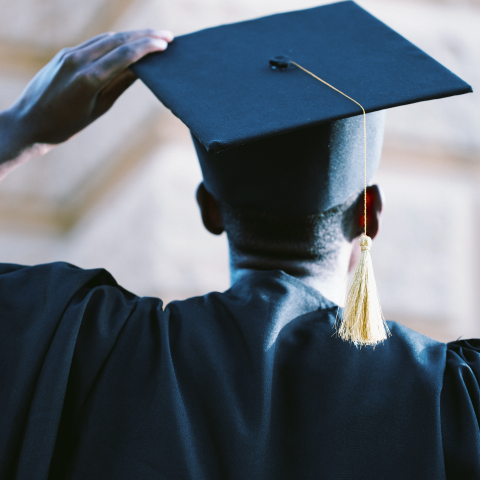Our theory of Learning Transformation
The U.S. Program within the Bill & Melinda Gates Foundation includes a team focused on Digitally-Enabled Teaching & Learning as a mechanism for improving equity and the learning experience across U.S.-based postsecondary institutions. Below is our vision for the field and where we, as a team, are mobilizing resources to Transform Learning.
The problem
Inequitable gateway courses lead to high DFWI rates
Each year, more than 3 million students enroll in roughly 20 introductory, credit-bearing general education courses that serve as prerequisites for other classes required for degree completion. These courses, sometimes termed “gateway courses,” are often not designed for student success and instead act as “gatekeepers” to attaining a degree or credential. The result is high DFWI rates (the percentage of students who complete the course with a D/F grade, Withdrawal, or Incomplete) across the board, with rates as high as 47% among students who are Black, Latino, or Indigenous.1 An analysis of gateway courses at 340 institutions found gaps in pass rates by race and ethnicity were as significant as 14.9% in Statistics and 12.8% in Chemistry.2 Students’ income on its own does not have a significant impact on outcomes with there being a difference in pass rates of 2% in Statistics and 0.7% in Chemistry. However, when students’ income as well as their race and/or ethnicity are considered, income can create drastic differences even among students with the same race and/or ethnicity. Additionally, the gap in rates between public 2-year and 4-year institutions is 10.5% for Statistics and 3.3% for Chemistry.
If students cannot complete their required gateway courses, they also cannot advance to take courses that count towards their fields of study and transfer and/or graduation. Despite the deep commitment and high academic potential of impacted students, poor outcomes in gateway courses have hurt students’ lives and job prospects: high drop-out rates between the first and second academic year; longer time to a degree; higher cost of degree; higher rates of student debt; as well as potential loss of financial assistance tied to academic performance. This is especially true in math and science: Black and Latinx workers are underrepresented in STEM professions by 2 and 9 percentage points respectively.3,4
The fault does not lie with students, but with the systems and resources that are not designed for their success.
The root cause
Institutions were built upon long-standing expectations and assumptions about what learning is and who can and should have access to learning
Trends in outcomes today are reflective of a systemic problem. Underlying high DFWI rates for students, especially students of color and from low-income backgrounds, are institutions that are “beneficiaries and defenders” of the racist and classist ideals upon which they were founded.7 A history of exclusivity and redlining in public education has resulted in inequitable access to schools and learning conditions, the impacts of which are felt decades later through significant disparities in educational outcomes by race and income.8
Courses designed to weed students out rather than support their success are built upon this legacy. The content and delivery of gateway courses are not based on best practices. In addition to not being conducive to learning, they leave students feeling demoralized and disengaged.
The traditional lecture model is not working
Traditional methods of teaching have shown to be less effective than active learning, A metastudy of 225 studies showed that students in classes with traditional lecturing were 1.5 times more likely to fail than were students in classes with active learning.9 Yet, this remains the predominant form of teaching at the postsecondary level.
Students do not find content relevant or engaging
Interviews with students show that they desire real-world and relevant content that allows them to connect their learning with their interests and career pathways.
As a Hispanic, you never feel like the word problem is about you. Names like Rob, Joe — small things like that you think this is normal, but never feel like it’s about you.
Instructors are not adequately trained and supported
Postsecondary learning is occurring within a system that undervalues teaching, and instructors cannot be expected to offer equitable and effective learning experiences if they are not trained in pedagogy, provided with ongoing professional learning, and supported with appropriate rewards, recognitions, and resources. Part-time instructors, who often teach gateway courses, enjoy few benefits, low pay, and less institutional access to professional development.10
These are just some of the challenges facing students today. The inequitable outcomes of gateway courses – and in higher education, writ large – require holistic, multi-faceted strategies that address institutional policy and reform, student support and belonging, instructor practice and training, curriculum design, and more.
Our vision for the future
Pedagogy, curriculum, and technology
Research shows that student learning and experiences are positively impacted by 1) pedagogical skill and practice of instructors, 2) relevant curriculum, and 3) innovative technology.
Pedagogy & Curriculum
Student experiences and student learning are influenced by many factors, such as the preparation and pedagogical skill of educators, encouragement and support from peers and instructors, how learning outcomes are assessed, how assessment data are used to drive change, and the departmental and institutional policies that influence what happens in the classroom. Our work accelerates the development of aligned and learner-centered course materials, instructor materials, and assessment tools that help identify students’ real-time strengths and challenges.
An analysis of RCT studies found that the disparity in academic performance between underrepresented minority students as well as students from low-income backgrounds and their peers decreased by 33% for students that were in an active learning course vs. traditional lecture.11
Innovative Technology
In our vision for the future, we see digital learning tools as a catalyzing force for transformative teaching and learning and equitable student success. Technology will become an integral part of most courses, regardless of whether they are taught online or in person. Technological tools have the potential to enhance student choice, enable real-time feedback, and personalize course content based on each student’s behavior or knowledge.
Impact
We are committed to transforming educational outcomes for students who are Black, Latino, Indigenous, or from low-income backgrounds through investing in curriculum, pedagogy, and technology enhancements. By focusing on the redesign of gateway courses, which engage millions of students annually, we seek to not only improve graduation and transfer rates, but also save students time and a collective $1 billion in unnecessary expenses associated with repeated or failed gateway courses. Our initiatives are designed to dismantle systemic barriers and ensure a more equitable future for all students.

Pass rates increased from 76% to 85% for Latino students and 62% to 82% for Black students in a recent analysis of adaptive courseware implementations in general education courses.11

